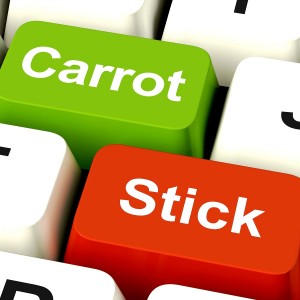Reward vs. Punishment as Workplace Tools: You Think You Know How to Use Them?

A boss wants his employees to do better, and, ideally, their best.
But, of course, sometimes they make mistakes.
Should they be punished for these, in addition to or instead of rewarded for the times they get it right?
Assume that the boss wants to “teach” the employee “a lesson”. If an employee rewarded for doing a job right or well is compared with an employee punished for doing he same job wrong, which one has learned the clearer “lesson”.
Now You’ve Learned Your Lesson!
You may be tempted to say “the one that got punished—that’s because, when we say, ‘You’ve learned your lesson’, we are almost always talking about a punishing experience.” But, think again.
That negative imagery and association would transform all of your learning accomplishments that have been based on “lessons” into punishment—which, despite how bored and restless we may have been in high school classes, include in life many rewarded performances as well as some rewarding experiences and lessons.
The Uncertainties of Getting It Wrong
Even though there may be more than one way to do something right, when an employee has done it, (s)he knows she doesn’t have to wonder what to do next time: just do the same thing again. That’s the message and lesson of the reward. Clear, simple.
However, when the employee has done something wrong, and even if there were only one way to do it wrong, that employee still doesn’t necessarily know what to do next. The situation becomes even more confusing if there are many, perhaps countless ways to do a given thing the wrong way.
For example, imagine a kid trying and failing to hit a baseball with a coach who shouts only “No. Not like that! That’s terrible! Try again!” Is the problem visual tracking of the ball? Uneven, early, late, high or low swing?
Even though as guidance the coach’s remarks are barely, if at all, helpful, the kid can discover the right way to swing—the moment (s)he hits the ball. Many employees are not so lucky. A boss complains, “This is terrible!”, e.g., regarding a secretary’s letter written for him, but provides no suggestions as to how to improve the letter. The secretary feels “punished”, but hasn’t learned what or how to change.
Lesson: It is more effective as a learning tool to reward an employee for getting something right than to punish him or her for getting it wrong. Of course, the trick is to get the employee to do it right.
Paradoxes of Punishment
Interestingly and paradoxically, from the scientific standpoint, positive suggestions from the boss about what to change in the letter can also and nonetheless count as punishment, because a key scientifically-defined characteristic of “punishment” is “anything that is intended to or actually decreases the likelihood of a repetition of a previous response”.
“Punishment”, as understood in behavioral shaping and control, is defined this way, i.e., as anything that makes behavior less likely, not in terms of subjective paind or other “unpleasantness”.
(If what is decreased is the probability of an imminent, completely new response, then this becomes a special case of inhibition, rather than punishment, which, of course, is inhibiting in its own way).
Hence, gently telling the secretary that the text needs to be justified or that there are double negatives (“didn’t do nothing”) can nonetheless be conceived as punishment to the extent that these remarks are intended to and may decrease the probability of a re-occurrence of these shortcomings.
The point here is that it is important to distinguish punishment as pain from punishment as probability reducer. An enlightened boss will utilize the latter, while, as much as possible, eschewing the former.
(Alternatively, the boss can be seen as “reciprocally inhibiting” mistakes by rewarding better writing behavior incompatible with mistake behavior.)
But we have to be careful about here is regarding decreased probability of response as conclusive evidence of punishment. For example, if a friend buys and you eat a fourth Big Mac, the probability of your buying-eating chained-response will almost certainly decrease, at least temporarily, if not permanently—if it makes you sick to your stomach. Does that make that last Big Mac a (self-) punishment tool?
If it does, then all satiation and satisfaction-creating situations become forms and moments of punishment—which, on the face of it, seems counter-intuitive.
That would mean that a big bonus that meets all of an employee’s financial needs would be punishment if it led to the employee’s quitting or merely not working so hard—because it would reduce the probability of the same previous level of high performance.
This kind of paradox can be partially prevented by stipulating that the behavior that becomes less likely has to be undesirable behavior, e.g., writing bad letters or stealing, to constitute punished behavior.
When “good” behavior becomes less likely because of its consequences, e.g., what someone does in response to it, we should consider such cases to be instances of satiation, closure or of stupidly punishing good behavior.
In general, punishment, including of an employee, can be conceived as application of an “aversive” stimulus after the behavior is displayed, e.g., a reprimand or a demotion—anything with the expected impact of a spanking.
However, one problem with this is that what is intended as punishment may not have that effect on the one targeted for punishment. “Negative attention seeking” is an example of this–for example, instances in which children or employees will deliberately provoke negative responses, even if only to get attention—any attention.
Another illustration is the fact that some people like to be “spanked”; so, whether or not the “punishment” is perceived as and responded to as such by the employee depends on one thing—unfortunately, that one thing is whether or not the “punishment” decreases the probability of the undesired behavior (and not just whether the applied sanction was intended as punishment).
_______________
Next: Part 2, “When Workplace Rewards Backfire”

